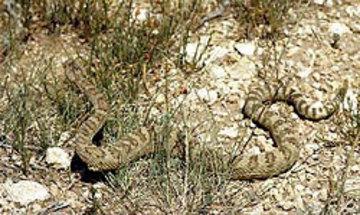When venomous snakes that endanger humans are moved elsewhere, translocation reduces survival rates. Snakes moved longer distances fare worse. At Great Basin National Park, wildlife biologists are studying translocated snakes to determine what translocation distance is “far enough.”
Venomous snakes, at least the native ones, are welcome in our national parks. But when these potentially dangerous reptiles turn up in the wrong places, such as park residential areas, campgrounds, visitors centers, busy trails and roads, and scenic overlooks, the potential for conflict often triggers intervention.
Killing a nuisance snake is not an option in a national park, so the normal procedure is to capture the snake and move it to a less problematic location. Park staff with appropriate training and experience can do this with little risk to themselves.
Unfortunately, studies have shown that translocated snakes have lower survival rates than snakes that are not moved. Distance matters, too. Snakes moved long distances – more than one kilometer (.62 miles) – have survival rates conspicuously lower than those moved shorter distances.
How far is “far enough”? Conceptually, it means a distance that is sufficient to eliminate the human-snake conflict that prompted the translocation without exposing the snake to unnecessary risk. Put into operation, it means that you stop after you reach an optimal distance because going further doesn’t make good sense.
Short distance moves of 100 meters or less are the preferred management option for rattlesnakes translocated in national parks. However, the argument for moves of this length rests mostly on anecdotal evidence or unstructured observation. Given a choice, wildlife managers would much rather base their managerial policies and practices on the results of empirical studies using scientific methods.
At Great Basin National Park, wildlife biologists are conducting such a study. The research findings will help to fine-tune current translocation guidelines for the park’s Great Basin rattlesnake (Crotalus lutosus). The Great Basin rattlesnake study is elegantly simple in design, if small in scale. Wildlife biologists had a veterinarian surgically implant temperature-sensing radio transmitters in three rattlesnakes, then released them within 100 meters of their capture sites. Each snake’s location and temperature (a key indicator of well-being) will be recorded weekly.
When scientists get good data, they try to make it serve as many useful purposes as practicable. Thus while the main goal here is put human-snake conflict reduction and associated tranlocation procedures on a more nearly scientific footing, the researchers expect the study to tell us useful things about rattlesnake natural history, movement patterns, and hibernacula (hibernation/overwintering shelters).
Postscript: And speaking of distance………. Go to this site and click on the speaker icon in the middle of the page about a third of the way down. .If you can hear this sound, you might consider putting some more distance between you and Crotalus lutosus.




Comments
I'm not sure what the issue is with Great Basin snakes, but I assume it's similar to problems with longer translocations of nuisance rattlers alluded to in a 2001 study Relocation of Nuisance Rattlesnakes: Problems Using Short-Distance Translocation in a Small Rural Community, which included this information:
I guess the bottom line here is that longer translocations leave the rattlers extremely upset, confused, and more likely to take lethaly dangerous risks while trying to find their way back to familiar habitat.
While working in one of the densest population areas of timber rattlers in the east, we were made aware of the study noted in the above message conducted in North Carolina. We started to relocate rattlers found in visitor use areas much shorter distances. Although we did not have the time to conduct any semblance of a scientific study, it did not seem that the snakes were returning to the high visibility areas frequented by people. I would find it of interest to see a study conducted on the movement of snakes relocated and the frequency that they reappear in areas that are of concern.
Just a thought for consideration by one of those grad students looking for a research topic.